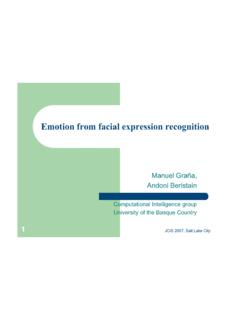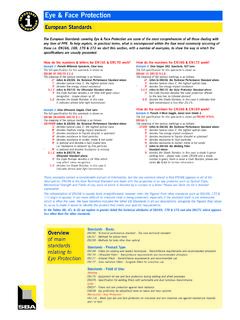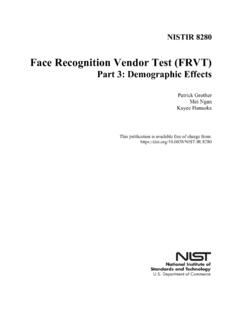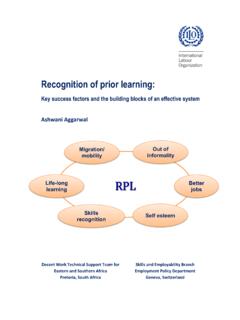Transcription of A PROJECT REPORT ON FACE RECOGNITION SYSTEM WITH …
1 A PROJECT REPORT ON FACE RECOGNITION SYSTEM WITH FACE DETECTION A PROJECT REPORT is submitted to Jawaharlal Nehru Technological University Kakinada, In the partial fulfillment of the requirements for the award of degree of BACHELOR OF TECHNOLOGY In ELECTRONICS AND COMMUNICATION ENGINEERING Submitted by SAI 13KQ1A0475 13KQ1A0467 KUMAR 14KQ5A0411 14KQ5A0412 Under the guidance of Ms. SK. AYESHA, Assistant Professor of dept DEPARTMENT OF ELECTRONICS AND COMMUNICATION ENGINEERING PACE INSTITUTE OF TECHNOLOGY AND SCIENCES (Affiliated to Jawaharlal Nehru Technological University Kakinada, Kakinada &Accredited by NAAC A grade An ISO 9001-2008 Certified Institution) NH-5, Valluru Post, Prakasam District, 523272, (2013-2017) PACE INSTITUTE OF TECHNOLOGY & SCIENCES (Affiliated to Jawaharlal Nehru Technological University Kakinada, Kakinada) (An ISO 9001-2008 Certified Institution)
2 Department of Electronics &Communication Engineering CERTIFICATE This is to certify that the PROJECT work entitled as FACE RECOGNITION SYSTEM WITH FACE DETECTION is being Submitted by 13KQ1A0475, 13KQ1A0467, 14KQ5A0411, 14KQ5A0412, in the partial fulfillment for the award of the Degree of Bachelor of Technology in ELECTRONICS AND COMMUNICATION ENGINNERING in the academic during 2013-2017. Under the esteemed Guidance of Ms. SK. AYESHA ASSISTANT PROFESSOR ASSOCIATE External Examiner Head of the Department Mr. , , ,( ) PROFESSOR&HOD ACKNOWLEDGEMENT I thank the almighty for giving us the courage and perseverance in completing the PROJECT itself is acknowledgements for all those people who have give ustheir heartfelt co-operation in making this PROJECT a grand success.
3 I extend our sincere thanks to GOPAL RAO, , , Chairman of our college, for providing sufficient infrastructure and good environment in the College to complete our course. I am thankful to our secretary Mr. M. SRIDHAR, , for providing the necessary Infrastructure and labs and also permitting to carry out this PROJECT . I am thankful to our principal RAO, , , , MISTE for providing the necessary infrastructure and labs and also permitting to carry out this PROJECT . With extreme jubilance and deepest gratitude, I would like to thank Head of the Department, , , MBA, ( ) for his constant encouragement. I special thanks to our PROJECT coordinator PRASAD, , Associate Professor, Electronics and Communications engineering, for his support and valuable suggestions regarding PROJECT work. I am greatly indebted to PROJECT guide , , Assistant Professor, Electronics and Communications engineering, for providing valuable guidance at every stage of this PROJECT work.
4 I am profoundly grateful towards the unmatched services rendered by him. Our special thanks to all the faculty of Electronics and Communications Engineering and peers for their valuable advises at every stage of this work. Last but not least , we would like to express our deep sense of gratitude and earnest thanks giving to our dear parents for their moral support and heartfelt cooperation in doing the main PROJECT . FACE DETECTION SYSTEM WITH FACE RECOGNITION ABSTRACT The face is one of the easiest ways to distinguish the individual identity of each other. Face RECOGNITION is a personal identification SYSTEM that uses personal characteristics of a person to identify the person's identity. Human face RECOGNITION procedure basically consists of two phases, namely face detection, where this process takes place very rapidly in humans, except under conditions where the object is located at a short distance away, the next is the introduction, which recognize a face as individuals.
5 Stage is then replicated and developed as a model for facial image RECOGNITION (face RECOGNITION ) is one of the much-studied biometrics technology and developed by experts. There are two kinds of methods that are currently popular in developed face RECOGNITION pattern namely, Eigenface method and Fisherface method. Facial image RECOGNITION Eigenface method is based on the reduction of face-dimensional space using Principal Component Analysis (PCA) for facial features. The main purpose of the use of PCA on face RECOGNITION using Eigen faces was formed (face space) by finding the eigenvector corresponding to the largest eigenvalue of the face image. The area of this PROJECT face detection SYSTEM with face RECOGNITION is Image processing. The software requirements for this PROJECT is matlab software. Keywords: face detection, Eigen face, PCA, matlab Extension: There are vast number of applications from this face detection PROJECT , this PROJECT can be extended that the various parts in the face can be detect which are in various directions and shapes.
6 INDEX CONTENTS page LIST OF FIGURES ABSTRACT FACE FACE 2. LITERATURE BASE DEFORMABLE POINT DISTRIBUTION MODEL(PDM)..6 LOW LEVEL GRAY SCALE EDGE FEATURE FEATURE CONSTELLATION NEURAL LINEAR SUB SPACE STASTICAL 3. DIGITAL IMAGE DIGITAL IMAGE FUNDAMENTAL STEPS IN IMAGE ELEMENTS OF DIGITAL IMAGE PROCESSING A SIMPLE IMAGE FORMATION 4.
7 MATLAB's POWER OF COMPUTAIONAL FEATURES OF USES OF UNDERSTANDING THE MATLAB COMMONLY USED OPERATORS AND SPATIAL COMMANDS FOR MANAGING A INPUT AND OUTPUT M DATA TYPES AVAILABLE IN 5. FACE FACE DETECTION IN REAL TIME FACE FACE DETECTION FACE DETETION 6. FACE FACE RECOGNITION USING GEOMETRICAL FACE RECOGNITION USING TEMPLATE PROBLEM SCOPE AND SYSTEM BRIEF OUTLINE OF THE IMPLEMENTED FACE RECOGNITION INTER CLASS INTRA CLASS PRINCIPAL COMPONENT UNDER STANDING EIGEN IMPROVING FACE DETECTION USING POSE INVARIENT FACE 7. 8. REFERENCES ..49 9. LIST OF FIGURES FACE DETECTION DETECTION FACE FUNDAMENTAL STEPS IN DIGITAL IMAGE ELEMENTS OF DIGITAL IMAGE PROCESSING A SUCCESSFUL FACE DETECTION IN AN IMAGE WITH A FRONTAL VIEW OF A HUMAN FRAME 1 FROM FRAME 2 FROM SPATIO - TEMPORALLY FILTERED FACE AVERAGE HUMAN FACE IN AREA CHOSEN FOR FACE : BASIS FOR A BRIGHT INTENSITY INVARIANT SENSITIVE SCANED IMAGE FACE DETECTION MOUTH 5.
8 NOISE EYE FACE RECOGNITION USING TEMPLATE IMPLEMENTED FULLY AUTOMATED FRONTAL VIEW FACE DETECTION : PRINCIPAL COMPONENT ANALYSIS TRANSFORM FROM 'IMAGE SPACE' TO 'FACE SPACE'..37 FACE FACE RECOGNITION TWINS AND FATHER AND A 7X7 FACE IMAGE TRANSFORMED INTO A 49 DIMENSION POSE INVARIANT FACE Department of ECE Page 1 CHAPTER-1 INTRODUCTION Face RECOGNITION is the task of identifying an already detected object as a known or unknown the problem of face RECOGNITION is confused with the problem of face detectionFace RECOGNITION on the other hand is to decide if the "face" is someone known, or unknown, using for this purpose a database of faces in order to validate this input face. FACE RECOGNIZATION: DIFFERENT APPROACHES OF FACE RECOGNITION : There are two predominant approaches to the face RECOGNITION problem: Geometric (feature based) and photometric (view based).
9 As researcher interest in face RECOGNITION continued, many different algorithms were developed, three of which have been well studied in face RECOGNITION literature. RECOGNITION algorithms can be divided into two main approaches: 1. Geometric: Is based on geometrical relationship between facial landmarks, or in other words the spatial configuration of facial features. That means that the main geometrical features of the face such as the eyes, nose and mouth are first located and then faces are classified on the basis of various geometrical distances and angles between features. (Figure 3) 2. Photometric stereo: Used to recover the shape of an object from a number of images taken under different lighting conditions. The shape of the recovered object is defined by a gradient map, which is made up of an array of surface normals (Zhao and Chellappa, 2006) (Figure 2) Popular RECOGNITION algorithms include: 1.
10 Principal Component Analysis using Eigenfaces, (PCA) 2. Linear Discriminate Analysis, 3. Elastic Bunch Graph Matching using the Fisherface algorithm, Department of ECE Page 2 . FACE DETECTION: Face detection involves separating image windows into two classes; one containing faces (tarning the background (clutter). It is difficult because although commonalities exist between faces , they can vary considerably in terms of age, skin colour and facial expression. The problem is further complicated by differing lighting conditions, image qualities and geometries, as well as the possibility of partial occlusion and disguise. An ideal face detector would therefore be able to detect the presence of any face under any set of lighting conditions, upon any background. The face detection task can be broken down into two steps. The first step is a classification task that takes some arbitrary image as input and outputs a binary value of yes or no, indicating whether there are any faces present in the image.)







